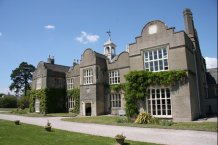A new archaeological study by a team of University of Exeter students could reveal more about one of the county’s oldest buildings – Old Forde House in Newton Abbot.

Old Forde House is grade 1 listed and currently home to Teignbridge District Council. The original house was built in the mid-16th century and added to later. King Charles I stayed at the house overnight in 1625 on his way to Plymouth. In 1646 during the Civil War, Forde House gave shelter to Oliver Cromwell and Colonel Fairfax. William of Orange stayed at the house in 1688 on the way to his coronation in London having landed in Brixham a few days earlier.
In January, the team used state-of-the-art equipment to try to discover previously unknown buildings or structures buried underground beneath the house and in the grounds. It was also an opportunity for members of the public to get involved with the research process. The team was led by third-year student Dan Brock, who gives us an update…
Following a successful week of data collection at the beginning of January, we are in the process of analysing and writing up the results of the survey of the grounds of Old Forde House. This process is expected to be completed in late April, with the full findings to be made publicly available through Teignbridge District Council in May. The fieldwork succeeded in providing a group of students and members of the public with the opportunity to learn and develop geophysical survey skills.
An open day on Friday 11th January attracted over 50 members of the public, amongst them local historians, aspiring archaeologists and prospective students. During the day, people were able to chat with members on the team about all things archaeology and even got the opportunity to try out some of the techniques that the team was using. Further, the survey attracted the attention of several local media outlets, including BBC Radio Devon and Devon Live.
Though the data has yet to be analysed in detail, initial observations indicate that there are extensive archaeological features within the grounds, but that these have been severely impacted by modern landscaping over many years. As a result, many of the original features of the grounds have been obscured, destroyed, or buried to the point of being undetectable with the techniques employed during this survey.
Despite this, a number of structural remains were detected in the immediate vicinity of the house. The most notable of these features appears to be an elaborate knot garden which is likely to date to the early 17th century. The dating and phasing of the various features around the house are not yet clear, however research and further analysis of the data should clarify the various phases of development that the house and grounds went through.
This survey would not have been possible without the fantastic group of students and volunteers who gave their time to collect the data or the staff of Teignbridge District Council who were incredibly accommodating and should be recognised for their contribution to this survey.
